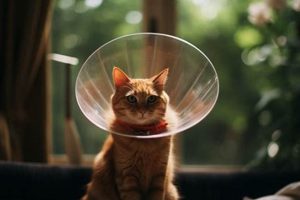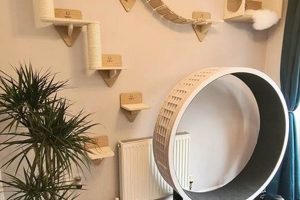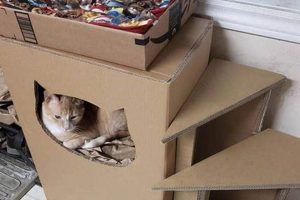The concept involves the creation of attire for feline companions using readily available materials and handcrafted techniques. Examples include repurposing fabric scraps into miniature capes, transforming cardboard into themed enclosures, or fashioning headwear from felt. These homemade creations offer alternatives to commercially manufactured pet apparel.
Constructing pet apparel offers several advantages. It allows for customization to precisely fit the animal’s dimensions, ensuring comfort and safety. It can also be a cost-effective approach, utilizing recycled or inexpensive materials. Historically, pet owners have crafted items for their animals, driven by practicality and a desire for personalized expression.
Subsequent sections will elaborate on various methods for developing pet outfits, discuss considerations for ensuring the animal’s well-being, and provide inspiration for a range of designs suitable for different skill levels and resource availability.
Crafting Feline Attire
The creation of homemade apparel for cats necessitates careful consideration of safety, comfort, and the animal’s behavioral needs. The following guidelines provide a framework for responsible and successful implementation.
Tip 1: Prioritize Safety: Avoid the use of small, detachable components such as buttons, beads, or ribbons. Ingestion of these items poses a significant choking hazard and potential for internal injury.
Tip 2: Ensure a Comfortable Fit: Garments should not restrict movement or impede breathing. Measure the cat accurately and allow for adequate room when cutting and sewing fabric. Loose fitting designs are often preferable.
Tip 3: Choose Appropriate Materials: Opt for soft, lightweight, and breathable fabrics. Avoid materials that may cause overheating or skin irritation. Natural fibers like cotton are generally suitable.
Tip 4: Monitor the Cat’s Reaction: Introduce attire gradually and observe the cat’s behavior closely. If the animal exhibits signs of distress, such as excessive scratching, biting, or attempts to remove the garment, discontinue use.
Tip 5: Keep It Simple: Elaborate designs are often unnecessary and may increase the risk of discomfort or entanglement. Focus on creating simple, functional garments that serve the intended purpose without causing undue stress to the animal.
Tip 6: Consider Limited Duration: Attire should only be worn for short periods of time, under direct supervision. Prolonged use can lead to overheating, skin irritation, or behavioral problems.
Tip 7: Provide Positive Reinforcement: Associate the experience of wearing attire with positive reinforcement, such as treats or praise. This can help to reduce anxiety and encourage acceptance.
Adherence to these guidelines will significantly minimize the potential for negative outcomes and contribute to a positive experience for both the creator and the feline subject.
The subsequent section will address common challenges encountered during the creation process and offer solutions for overcoming these obstacles.
1. Safety and comfort paramount
The principle of ensuring safety and comfort is of utmost importance in the creation of attire for feline companions. Neglecting these considerations can lead to physical harm, psychological distress, and potential behavioral issues in the animal. This principle is fundamental to responsible pet ownership when engaging in any activity that alters the animal’s physical state or environment.
- Material Selection
The selection of appropriate materials directly impacts both the safety and comfort of the feline. Fabrics should be non-toxic, breathable, and free of potentially irritating dyes or finishes. Avoidance of small, detachable embellishments, such as buttons or sequins, minimizes the risk of ingestion and choking. Natural fibers, like cotton or linen, are generally preferred over synthetic materials, as they allow for better air circulation and reduce the risk of overheating. The chosen fabric should also be durable enough to withstand normal feline activity without tearing or fraying, which could pose an entanglement hazard.
- Fit and Restriction
Proper fit is crucial to preventing injury or distress. Attire should allow for a full range of motion without constriction or chafing. Restrictive garments can impede breathing, circulation, and normal grooming behaviors. The design should accommodate the feline’s natural anatomy and avoid placing pressure on sensitive areas, such as the throat or abdomen. Elastic components should be carefully chosen to provide a secure fit without being overly tight. It is often advisable to err on the side of a looser fit, prioritizing freedom of movement over aesthetic concerns.
- Monitoring and Supervision
Even with careful material selection and proper fit, continuous monitoring is essential. The feline’s behavior should be closely observed for any signs of discomfort, anxiety, or irritation. Signs of distress may include excessive scratching, attempts to remove the garment, panting, or changes in vocalization. Attire should only be worn for short periods of time and under direct supervision. Prolonged use can lead to overheating, skin irritation, or behavioral problems. If any adverse reactions are observed, the attire should be immediately removed, and its design reassessed.
- Design Simplicity
Designs for feline garments should be simple and functional, minimizing the potential for entanglement or injury. Complex designs with multiple layers, straps, or appendages can increase the risk of snags and restrict movement. Elaborate embellishments can also pose a choking hazard if they become detached. Simple, streamlined designs that prioritize functionality over aesthetics are generally the safest and most comfortable option for felines.
The interconnectedness of material selection, fit, monitoring, and design underscores the holistic nature of ensuring safety and comfort. When crafting attire for felines, it is imperative to prioritize these considerations above all else. A well-intentioned, but poorly executed, design can have negative consequences for the animal’s well-being. By adhering to these principles, it is possible to create attire that is both safe and comfortable, enhancing the bond between owner and pet without compromising the animal’s health or happiness.
2. Appropriate Material Selection
The selection of suitable materials is a pivotal aspect of creating homemade attire for feline companions. This choice directly influences the safety, comfort, and overall acceptability of the garment by the animal. Careful deliberation is required to mitigate potential risks and ensure a positive experience.
- Breathability and Thermoregulation
Fabrics should facilitate adequate air circulation to prevent overheating. Cats lack efficient sweat glands and are therefore susceptible to hyperthermia in poorly ventilated attire. Natural fibers such as cotton or linen offer superior breathability compared to synthetic alternatives like polyester or nylon. Example: A costume constructed from tightly woven polyester could lead to rapid overheating, especially during physical activity or in warm environments. Implications: Prioritizing breathable materials minimizes the risk of heat stress and contributes to the cat’s comfort, thereby increasing the likelihood of acceptance.
- Non-Toxicity and Allergenicity
Materials must be non-toxic to prevent adverse reactions from ingestion or skin contact. Cats frequently groom themselves, potentially ingesting small fibers or dyes present in the fabric. Certain dyes and finishes can also cause allergic dermatitis in sensitive animals. Example: Using fabric scraps from industrial sources may expose the cat to harmful chemicals or irritants. Implications: Sourcing materials from reputable suppliers and opting for hypoallergenic options reduces the risk of poisoning, allergic reactions, and skin irritation.
- Durability and Resistance to Damage
The material’s durability should withstand normal feline behavior, including scratching and grooming. Fragile fabrics are prone to tearing, creating potential entanglement hazards. Durable materials offer greater longevity and minimize the risk of loose threads or small parts that could be ingested. Example: Delicate lace or loosely woven knits are easily damaged by a cat’s claws, creating loose strands that could become wrapped around limbs or ingested. Implications: Selecting durable materials enhances the garment’s safety and lifespan, reducing the need for frequent repairs or replacements.
- Weight and Flexibility
Heavy or stiff materials can restrict movement and cause discomfort. The garment should be lightweight and flexible to allow for a full range of motion without hindering the cat’s natural activities. Cumbersome costumes are less likely to be tolerated and may induce stress. Example: Using heavy denim or stiff leather would significantly impede the cat’s mobility and likely result in resistance to wearing the garment. Implications: Choosing lightweight and flexible materials ensures that the attire does not restrict movement, promoting acceptance and minimizing stress.
The choice of appropriate materials is not merely an aesthetic consideration; it is a fundamental aspect of ensuring the well-being of the feline. By prioritizing breathability, non-toxicity, durability, and flexibility, creators can significantly enhance the safety and comfort of homemade attire, fostering a more positive experience for both pet and owner.
3. Accurate measurement essential
In the context of creating homemade attire for feline companions, precise dimensional data collection is paramount. Accurate measurement directly impacts the fit, comfort, and safety of the final product. A failure to obtain correct measurements can result in garments that are too restrictive, causing discomfort or hindering movement, or conversely, attire that is too loose, presenting a potential entanglement hazard. The ramifications of inaccurate measurements extend beyond mere aesthetics; they directly affect the animal’s well-being.
For instance, if the chest circumference is underestimated, the resulting garment may constrict the cat’s breathing or inhibit normal movement. Conversely, an overestimated neck circumference could lead to the attire slipping off or becoming entangled in the animal’s limbs, potentially causing injury. The practical application of accurate measurement involves utilizing a flexible measuring tape to determine the cat’s neck circumference, chest girth (measured behind the front legs), back length (from the base of the neck to the base of the tail), and leg circumference (if the design includes leg coverings). These measurements should be recorded precisely and consulted throughout the construction process. Patterns should be adjusted based on these individual dimensions to ensure a custom fit. Ignoring this step undermines the inherent advantages of crafting attire, negating the possibility of a perfectly fitted and comfortable garment.
Achieving accuracy in measurement presents challenges, particularly with uncooperative or restless animals. It may require patience, gentle handling, and the assistance of another individual to ensure the cat remains still during the process. Furthermore, it is prudent to add a small allowance (typically 1-2 centimeters) to the final measurements to accommodate movement and prevent constriction. The understanding of accurate measurement’s significance is not merely theoretical; it is a critical component of responsible pet ownership when engaging in activities that alter the animal’s physical environment. The benefits of a well-fitted garment, achieved through meticulous measurement, far outweigh the potential risks associated with inaccurate approximations.
4. Simple designs preferred
The preference for uncomplicated construction in the realm of crafting feline attire stems from several key factors that directly impact the animal’s well-being and the practicality of the creation process. Complex designs, characterized by multiple layers, intricate embellishments, or restrictive elements, often lead to discomfort, limited mobility, and increased risk of entanglement for the cat. Conversely, straightforward patterns utilizing basic shapes and minimal adornments prioritize the animal’s comfort and safety, fostering a more positive experience. For example, a simple cape secured with a loose tie at the neck presents less risk of constriction compared to a full-body suit with zippers and elastic bands. The selection of rudimentary designs is, therefore, a pragmatic choice dictated by the inherent limitations of working with animals and the ethical considerations of prioritizing their welfare. The preference is not merely aesthetic but fundamentally practical.
The application of simplified design principles extends beyond ethical considerations; it also enhances the accessibility and feasibility of these projects for individuals with varying skill levels. Intricate patterns require advanced sewing techniques and precise measurements, potentially discouraging novice crafters. Simplified designs, in contrast, utilize basic stitching and readily available materials, enabling a wider audience to participate in the activity. A simple felt hat, for example, requires minimal sewing experience and can be constructed using readily available materials, making it a viable project for beginners. Furthermore, streamlined designs often require less time and resources, rendering them more practical for individuals with limited availability. This accessibility fosters creativity and encourages responsible pet ownership by providing a low-barrier entry point to creating custom accessories for feline companions. It minimizes the reliance on commercially produced items that may not adequately address the specific needs and preferences of individual animals.
In conclusion, the emphasis on simple designs within the sphere of homemade feline attire represents a confluence of ethical considerations, practical constraints, and accessibility concerns. Prioritizing uncomplicated patterns minimizes the risk of discomfort and injury to the animal, while also increasing the feasibility and appeal of these projects for a broader range of individuals. The challenge lies in striking a balance between creative expression and responsible pet ownership, ensuring that the animal’s well-being remains the paramount consideration. The adoption of simple designs, therefore, emerges as a pragmatic and ethically sound approach to crafting accessories for feline companions.
5. Supervision during use
The act of directly observing a feline while it is adorned in homemade attire constitutes an indispensable aspect of responsible pet ownership. Attire, irrespective of its aesthetic appeal or perceived harmlessness, introduces potential risks that necessitate vigilant monitoring. The animal’s reaction to the garment can manifest in various ways, ranging from mild discomfort to overt distress. The absence of supervision inhibits the timely detection of adverse reactions, potentially leading to physical harm or psychological trauma. For example, a cat might become entangled in a loose strap, leading to panic and potential injury, or it may experience overheating due to inadequate ventilation within the attire. Prompt intervention is predicated upon constant surveillance.
Practical applications of vigilant observation extend beyond mere response to immediate emergencies. The ability to accurately assess the animal’s comfort level enables informed decisions regarding design modifications or material alterations. A cat exhibiting subtle signs of irritation, such as excessive scratching or attempts to remove the garment, provides valuable feedback that can be used to refine the construction process. This iterative approach, incorporating both observation and adjustment, maximizes the likelihood of creating attire that is both aesthetically pleasing and functionally suitable for the animal. Furthermore, supervision allows for the gradual acclimatization of the feline to the unfamiliar sensation of wearing clothing. Brief, supervised sessions can help to desensitize the animal and minimize anxiety associated with the attire.
In summation, continuous observation is not merely a precautionary measure; it is an integral component of the ethical creation and utilization of homemade attire for feline companions. The ability to detect subtle signs of distress, to refine designs based on observed reactions, and to gradually acclimate the animal to the experience underscores the practical significance of this principle. The challenges associated with maintaining constant vigilance are mitigated by the potential for preventing harm and fostering a positive experience for both pet and owner. This practice serves as a crucial link between creative expression and responsible pet ownership.
Frequently Asked Questions Regarding DIY Feline Attire
This section addresses common inquiries and concerns pertaining to the creation and use of homemade apparel for cats. Information presented aims to provide clarity and promote responsible pet ownership.
Question 1: Is it ethical to dress a cat in a costume?
The ethicality is contingent upon prioritizing the animal’s well-being. If the attire causes distress, restricts movement, or poses a safety hazard, it is deemed unethical. Attire should only be used if the animal tolerates it without exhibiting signs of anxiety or discomfort.
Question 2: What materials are safest for making feline attire?
Natural, breathable, and non-toxic materials are preferred. Cotton, linen, and hypoallergenic fabrics are suitable options. Avoid materials with small, detachable parts or potentially irritating dyes.
Question 3: How should a cat be measured for a homemade costume?
Utilize a flexible measuring tape to determine the cat’s neck circumference, chest girth, and back length. Ensure the cat is standing or lying comfortably. Add a small allowance to the measurements to accommodate movement.
Question 4: How long should a cat wear a costume?
Attire should only be worn for short periods, under direct supervision. Prolonged use can lead to overheating or skin irritation. Limit wearing time to a few minutes initially, gradually increasing as the animal acclimates.
Question 5: What are the signs that a cat is uncomfortable in a costume?
Signs of discomfort include excessive scratching, attempts to remove the garment, panting, changes in vocalization, or withdrawal. If any of these signs are observed, the attire should be removed immediately.
Question 6: Are there any costume designs that should be avoided?
Avoid designs that restrict movement, cover the animal’s face, or include small, dangling parts. Full-body suits, tight collars, and costumes with elastic bands are generally discouraged.
Key takeaways include prioritizing the animal’s comfort and safety, selecting appropriate materials, and monitoring the animal’s behavior closely. These principles are essential for responsible creation and use of feline attire.
Subsequent sections will explore alternative methods for enriching a feline’s environment without the use of restrictive apparel.
Concluding Remarks on DIY Costumes for Cats
The preceding analysis has explored various facets of fashioning homemade attire for feline companions. Emphasis has been placed on the paramount importance of safety, comfort, and responsible pet ownership. Material selection, accurate measurement, design simplicity, and constant supervision have been identified as critical elements in mitigating potential risks and ensuring the well-being of the animal. The ethical considerations surrounding this practice have also been examined, underscoring the need to prioritize the animal’s needs and preferences above purely aesthetic objectives.
The act of crafting attire for animals, while potentially engaging and creative, carries inherent responsibilities. Further research into animal behavior and welfare is encouraged to inform decision-making. The ultimate goal should remain the enhancement of the animal’s quality of life, not its subjugation to human desires. The decision to create and utilize such items must be approached with thoughtful consideration and a commitment to ethical practices.







